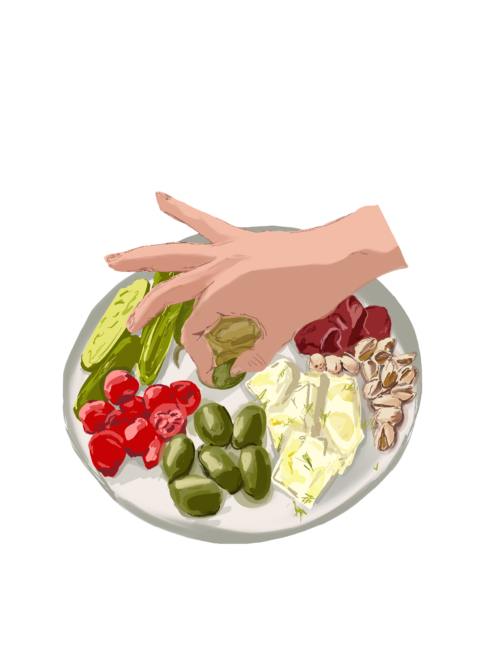We’re tired, we’re hungry, and we want food. To respond to these classic urges, female social media creators artistically craft their combination of leftover chicken, carrots, and bread and posting it on TikTok under #girldinner.
The Girl Dinner trend, in showcasing nontraditional and arguably incoherent dinners, has unveiled a fine line between promoting disordered eating and embracing alternative modes of femininity.
Though not its original intention,“Girl Dinner” has freed women from the responsibility of being designated dinner-makers. Whether it’s marketing peanut butter and chicken wings or Mac and Cheese and dino nuggets, the trend has normalized eating intuitively to one’s desire.
TikTok influencer Olivia Maher coined the phrase “Girl Dinner”—her original video posted in May of 2023 went viral with upwards of 1.5 million views. After Maher’s video was posted, other creators showed off their take on the trend causing the hashtag to begin to revolve around women posting on TikTok showing off their uncoordinated meals and celebrating the joy of snacking.
The trend has also shed light on an ongoing battle between young girls and their food: it can easily glamorize eating unbalanced, non-nutritious meals, which can be detrimental to an individual’s physical health and relationship with what they eat.
Moreover, creators who are using the hashtag to uplift women by showing their lazy dinners, showing that femininity doesn’t require one to be constantly put together, are invalidated by others who are using the trend with more superficial motives.
With 5.9 million followers on TikTok, influencer Alix Earle showed off her popcorn dinner drizzled with marinara sauce. Negative comments flooded the video; one commenter, @adotdrillz, said, “This is sad I feel bad for you I hope you get sum food,” and another, @lex1luvsyou, stated, “How in my anorexic life did I NEVER THINK TO SAUCE POP.”
Even though Earle—in posting a video of popcorn for dinner—may consider her content to be simply relatable, similar videos can easily encourage disordered eating. This is harmful in a world where eating disorders affect 9% of the population, and 75% of those impacted by Anorexia Nervosa identify as female.
Sophomore Matt Travaglini ’25, a lifestyle YouTube creator, says, “If someone had eating issues, per se, they would do the trend in a way to validate their unhealthy eating trends for themselves.” Young, malleable minds scroll through their TikTok feeds daily, consuming thousands of videos tailored to their exact algorithms. In an attempt to emulate influencers such as Earle’s lives, impressionable viewers may subconsciously seek to replicate her unorthodox dinner regimen.
Clara Rhoytan ’27, the founder of Dear Me, a non-profit centered around body positivity, says, “I don’t love when people, especially fitness influencers who have it as their entire job to look a certain way, are promoting the lifestyles and eating styles that they have, because young girls don’t need that.”
While TikTok users generally lack scientific evidence behind their judgmental comments, nutritionists also wonder if this trend is doing more harm than good and, more critically, if Girl Dinner is another case of problematic diet culture plaguing our feeds.
Registered dietitian Mackenzie Burgess commented on the slippery slope of the trend, providing in a July 2023 Health article that “Promoting [these meals] as Girl Dinner gives the impression that women need to have smaller portions or a special kind of meal compared to men.” To Travaglini, a viral plate of ice or carrots “definitely promot[es] unhealthy eating habits.”
However, the nutritional content of every Girl Dinner is not created equal, and the entire trend does not contribute to disordered eating and body image issues. On the other side, TikToker Isa Kristen posted a video of her Girl Dinner, which consisted of chicken legs, peanut butter on crackers, and a protein smoothie. She remarked that her take on Girl Dinner consisted of protein, fat, and carbs, comprising a full, healthy meal. Olivia Zhang ’27, who has 57,000 followers on TikTok, said, “I personally think [Girl Dinner] is just a fun trend. I feel like it’s a great way to be natural and authentic about how our meals sometimes look, especially as students.”*
In encouraging women to take agency over their meals, the hashtag has also diverged into a positive, feminist trend, allowing women to embrace authenticity in their eating habits. Nothing is more gratifying to a busy girl than indulging in a pile of low-effort, chaotic, and fulfilling snacks at the end of a long day, and knowing thousands of other girls are out there doing the same thing.
In an interview with The New York Times, Alana Laverty, a London-based content creator, proved her allegiance to the trend, saying, “There was this feeling of, ‘Oh my God, I’m not the only one … I love anything that celebrates something women are all doing, but we don’t all know that we’re doing it.” In her eyes, Girl Dinner not only rejects diet culture and the rigid expectations of how one should eat but also fulfills women with peace and enjoyment in their food.
In addition to Girl Dinners, the term “girl” is now being used to describe daily affairs such as “girl money, girl bathroom, or girl math.” The adjective communicates a whole range of contexts that typically only female-identifying people can understand. In taking pride in a wide range of female experiences, the term has forged a new identity for women, one that allows them to embrace and reinvent femininity.
*Quotes have been adjusted to account for filler words and grammatical correctness.
Lauren Barakett ’27 (laurenbarakett@college.harvard.edu) and Ellie Tunnell ’27 (ellie_tunnell@college.harvard.edu) ate a Girl Dinner while writing this article.

